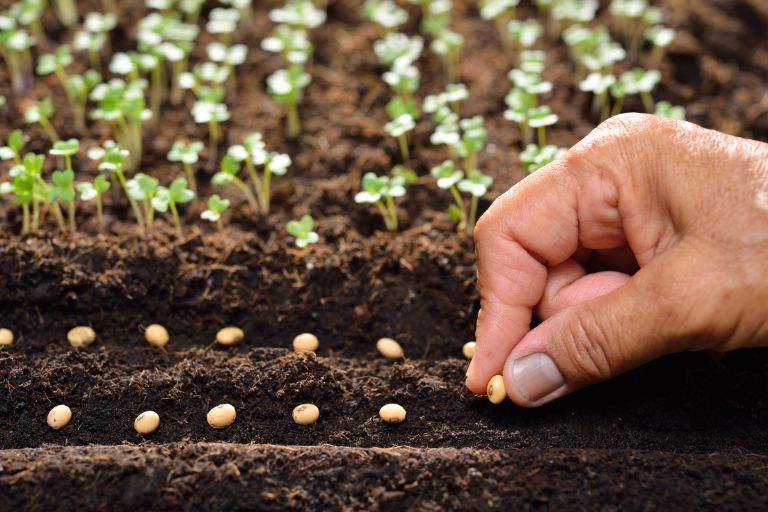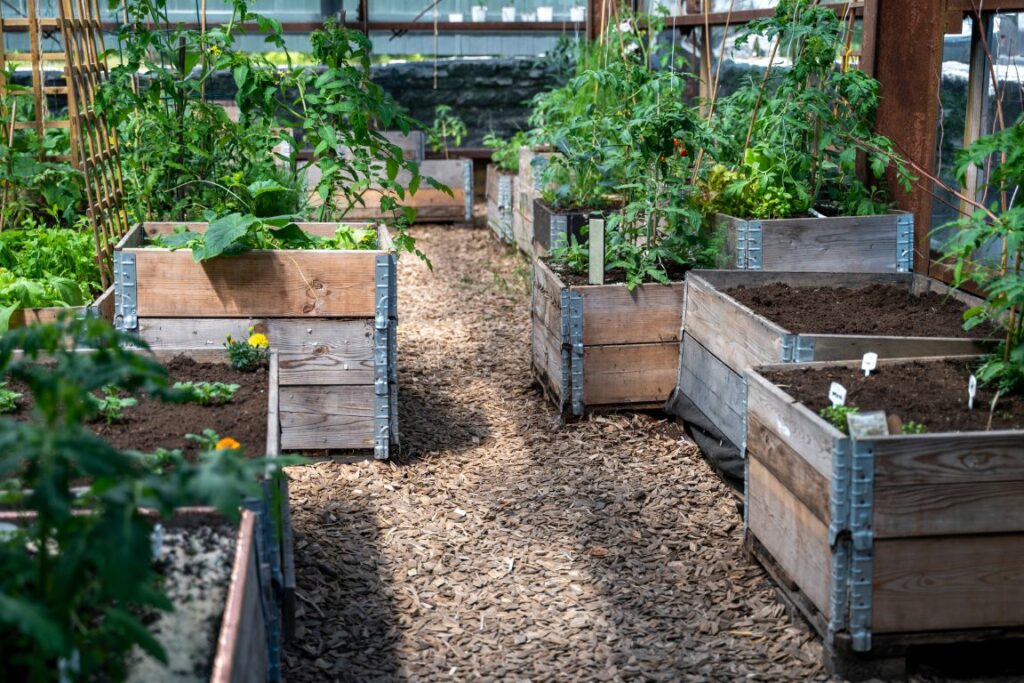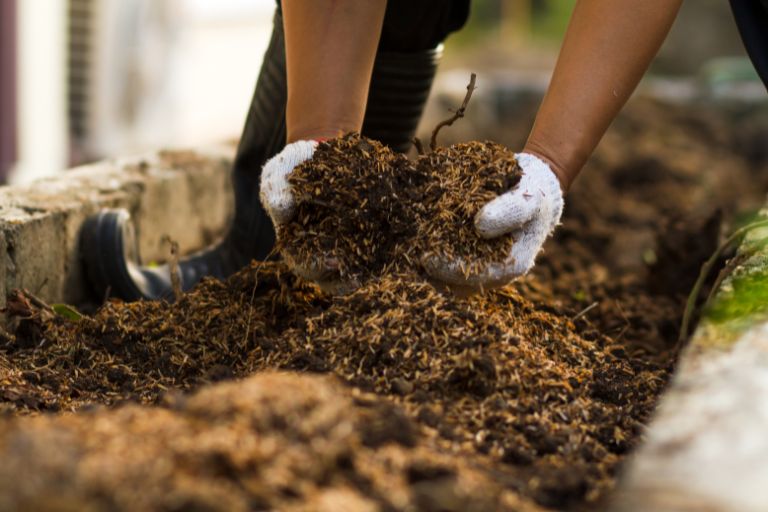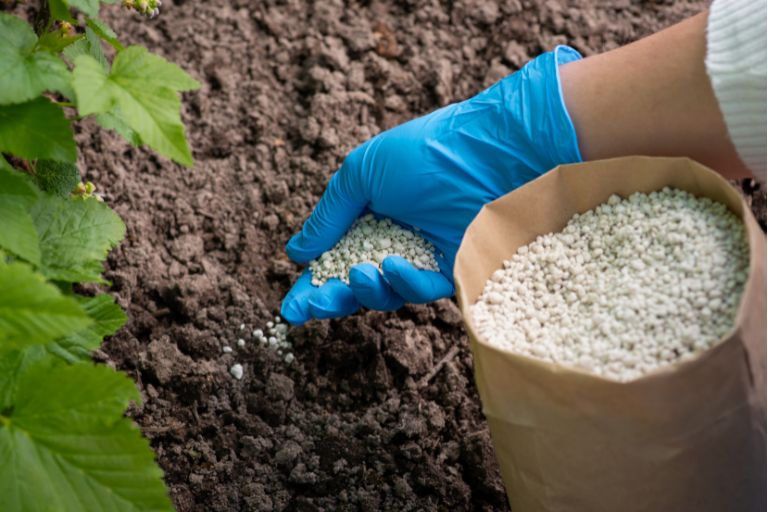Harnessing Rainwater: A Guide to Rainwater Harvesting for Garage Gardens

In the quest for sustainable living, every drop counts. As city dwellers and garden enthusiasts alike seek eco-friendly practices, rainwater harvesting is emerging as a beacon of resourcefulness and conservation. In the midst of concrete jungles, where green spaces are scarce, garage gardens stand as oases of nature, albeit in confined spaces. But even within these confined spaces, the potential for rainwater harvesting remains vast, promising a pathway to greener, more eco-conscious gardening practices.
Once relegated to rural landscapes, rainwater harvesting has found its place on the urban gardening scene, offering a lifeline to parched plants and a way to reduce reliance on municipal water supplies. Within the confines of garage gardens, where space is at a premium and sustainability is paramount, integrating rainwater harvesting systems not only conserves precious water resources, but also fosters a deeper connection with the natural world.
In this article, we delve into the world of rainwater harvesting for garage gardens, exploring its benefits, practicalities and potential for transforming small-scale gardening endeavours into models of sustainability. From understanding the mechanics of rainwater harvesting systems to practical tips on installation and maintenance, join us as we navigate the waters of this eco-friendly practice, paving the way for greener gardens and a brighter, water-wise future.
Understanding Rainwater Harvesting
Rainwater harvesting is the practice of collecting and storing rainwater that falls on roofs, pavements and other surfaces for later use. This collected rainwater can be used for a variety of purposes, including irrigation, landscaping, and even non-potable domestic uses such as toilet flushing or laundry washing. The importance of rainwater harvesting lies in its potential to address water scarcity issues, promote sustainable water management practices and reduce reliance on traditional water sources such as groundwater and municipal supplies. By capturing rainwater before it enters storm drains or evaporates, rainwater harvesting helps to conserve water resources, mitigate flooding and minimise water pollution by reducing storm water runoff. In addition, rainwater harvesting systems can help reduce water bills for homeowners and businesses, while fostering a greater sense of environmental responsibility and resilience in communities facing water challenges. Overall, rainwater harvesting plays a vital role in promoting water sustainability and resilience in both urban and rural areas.
Rainwater harvesting systems work by collecting rainwater run-off from roofs, driveways or other surfaces and directing it into storage tanks or cisterns for later use. The components involved in a rainwater harvesting system can vary depending on its complexity and intended use, but typically include the following:
Catchment area – The catchment area is the area where rainwater is collected. This is often the roof of a building, but can also include driveways, patios or other impervious surfaces.
Gutters and downspouts – Gutters are installed along the edges of the roof to collect rainwater and direct it to downspouts. The downspouts then direct the rainwater downwards to storage tanks or cisterns.
Screens and filters – Blade guards or gutter guards are installed over gutters to prevent leaves, debris and other large particles from entering the system. Filters can also be used to remove smaller particles and contaminants from the collected rainwater.
First flush diverters – First flush diverters are devices designed to divert the initial runoff from the catchment surface away from the storage tank. This helps to flush out any debris or contaminants that may have accumulated on the surface since the last rainfall.
Storage tanks or cisterns – Storage tanks or cisterns are used to store collected rainwater until it is needed. These can be above or below ground and come in a variety of sizes and materials such as plastic, concrete or metal.
Overflow system – An overflow system is needed to prevent the storage tank from overflowing during heavy rainfall. This can include overflow pipes or outlets that direct excess water away from the tank and into a drainage system.
Pump and distribution system (optional) – In some cases, a pump and distribution system can be installed to pressurise and distribute the harvested rainwater to where it is needed, such as for irrigation or non-potable domestic use.
In garage gardens, where space may be limited, different types of rainwater harvesting systems offer practical solutions for collecting and using rainwater efficiently. The following are some of the different types of rainwater harvesting systems suitable for garage gardens:
Rain barrels
– Rain barrels are one of the simplest and most common rainwater harvesting systems used in garage gardens. These barrels are typically placed under downspouts to collect rainwater run-off from the roof.
– They come in a range of sizes, typically between 50 and 100 gallons, making them suitable for smaller garden spaces.
– Rain barrels often have a tap near the bottom for easy access to the collected water, as well as an overflow outlet to prevent overfilling during heavy rainfall.
Rain chains
– A decorative alternative to traditional downspouts, rain chains consist of a series of linked chains or beakers that direct rainwater from the roof to the ground or a collection basin.
– While rain chains do not collect as much water as rain barrels, they can be incorporated into garage gardens to direct rainwater to plants or permeable surfaces for absorption.
Downspout diverters
– Downspout diverters are devices installed in downspouts to divert rainwater away from storm drains and towards specific areas for collection or infiltration.
– They may have a diverter valve that can be manually adjusted to divert water either to a rain barrel or directly into the ground for irrigation.
– Downpipe diverters are particularly useful in garage gardens where space constraints make it difficult to accommodate large storage tanks or barrels.
Permeable paving and surfaces
– In addition to traditional rainwater harvesting systems, permeable pavers and surfaces can be used in garage gardens to allow rainwater to infiltrate directly into the ground.
– Permeable paving materials, such as porous concrete or porous asphalt, allow rainwater to seep through gaps or pores in the surface, recharging groundwater and reducing run-off.
– This approach is particularly beneficial in garage gardens where there may not be enough space for conventional rainwater storage systems.
Benefits of Rainwater Harvesting for Garage Gardens
Rainwater harvesting reduces dependence on municipal water sources and conserves water through several key mechanisms:
Alternative water source – By collecting rainwater from roofs, driveways or other impervious surfaces, rainwater harvesting systems provide an alternative source of water for various non-potable uses such as garden irrigation, landscape maintenance and outdoor cleaning. This reduces the need for treated municipal water typically used for these purposes, thereby conserving freshwater resources.
Supplemental irrigation – Rainwater harvesting systems can supplement or replace conventional irrigation methods, such as sprinklers or hose watering, during dry periods. By using stored rainwater to irrigate gardens, homeowners can reduce their reliance on municipal water supplies, especially during droughts or water restrictions.
Reduced storm water runoff – In urban areas with extensive impervious surfaces such as rooftops and pavement, storm water runoff can contribute to storm water pollution and flooding. Rainwater harvesting systems intercept and capture rainwater before it reaches storm drains or waterways, reducing the volume and velocity of storm water runoff. This helps to mitigate the adverse effects of urban runoff on water quality and aquatic ecosystems, while conserving water resources.
Groundwater recharge – In addition to capturing rainwater for immediate use, rainwater harvesting systems can also contribute to groundwater recharge by allowing rainwater to infiltrate into the ground. Permeable surfaces, such as rain gardens or vegetated swales, can be incorporated into rainwater harvesting designs to facilitate groundwater recharge and reduce reliance on unsustainable groundwater extraction.
Financial savings – By reducing the use of municipal water, rainwater harvesting systems can lead to financial savings for homeowners through lower water bills. While the initial investment in rainwater harvesting infrastructure may require upfront costs, the long-term savings from reduced water bills and potential rebates or incentives offered by water utilities can offset these costs over time.
Cost-effectiveness is a major advantage of rainwater harvesting systems, as they offer the potential for significant savings on water bills by using free rainwater for garden irrigation. The following are some key points that highlight the cost effectiveness of rainwater harvesting:
Reduced water consumption – By using rainwater collected from roofs or other surfaces for garden irrigation, homeowners can significantly reduce their dependence on municipal water supplies. This translates into lower water consumption and therefore lower water bills, especially during dry seasons or water restriction periods when outdoor water use is restricted or subject to surcharges.
Elimination of irrigation costs – Rainwater harvesting systems eliminate the need to purchase and use potable water for garden irrigation, saving homeowners the recurring costs associated with water use for outdoor landscaping. Instead of paying for municipal water, homeowners can use the free and abundant resource of rainwater, reducing their overall water costs.
Long-term savings – While there are initial costs associated with installing rainwater harvesting infrastructure, such as storage tanks, gutters and filtration systems, these investments can provide long-term savings by offsetting future water bills. Over time, the cost of installing a rainwater harvesting system can be recouped through reduced water bills, resulting in overall cost effectiveness and financial benefits for homeowners.
Environmental benefits – In addition to cost savings, rainwater harvesting systems offer environmental benefits by promoting sustainable water management practices and reducing the environmental footprint associated with conventional water sources. By conserving water resources and minimising the energy required for water treatment and distribution, rainwater harvesting contributes to environmental conservation and resilience.
Potential rebates and incentives – Some municipalities, water utilities and government agencies offer rebates, incentives or tax credits to encourage the adoption of rainwater harvesting systems. These financial incentives can help offset the initial cost of installing rainwater harvesting infrastructure, making it even more cost-effective for homeowners to invest in water-saving technologies.
Rainwater harvesting plays a vital role in reducing storm water runoff and pollution, and benefits the environment in a number of ways:
Reducing storm water runoff – In urban areas with extensive impervious surfaces, such as rooftops, driveways and pavement, rainwater runoff can accumulate rapidly during rain events, leading to increased storm water runoff. This runoff can overwhelm storm water management systems, causing flooding, erosion and pollution of waterways. Rainwater harvesting systems intercept and capture rainwater before it reaches storm drains, reducing the volume and velocity of storm water runoff. By reducing storm water runoff, rainwater harvesting helps mitigate the adverse effects of urban flooding and erosion, protecting communities and infrastructure from water-related hazards.
Pollutant load reduction – Storm water runoff can carry various pollutants, including sediment, nutrients, heavy metals, pesticides and bacteria, from urban surfaces into waterways, threatening water quality and aquatic ecosystems. Rainwater harvesting systems remove pollutants by capturing rainwater and preventing it from entering storm drains and waterways. In addition, pre-filtration devices such as leaf screens and gutter guards can be installed to trap debris and pollutants before they reach storage tanks. By reducing the pollutant load in storm water runoff, rainwater harvesting helps protect water quality, preserve aquatic habitats and support biodiversity in rivers, lakes and streams.
Preserving natural hydrological processes – Traditional storm water management practices, such as underground drainage systems and concrete canals, disrupt natural hydrological processes by diverting rainwater away from the landscape and into storm drains. This alteration of the water cycle can lead to habitat loss, groundwater depletion and stream channelling, reducing the resilience of ecosystems to climate change and extreme weather events. Rainwater harvesting systems restore natural hydrological processes by capturing rainwater and allowing it to infiltrate into the ground, recharging groundwater supplies and supporting vegetation growth. By mimicking natural water flows, rainwater harvesting promotes ecosystem health and resilience and enhances the ecological integrity of urban and rural landscapes.
Conservation of water resources – In addition to reducing storm water runoff and pollution, rainwater harvesting conserves water resources by capturing and using rainwater for a variety of non-potable uses, such as landscape irrigation, toilet flushing and laundry washing. By reducing the need for treated municipal water, rainwater harvesting helps to relieve pressure on freshwater sources such as rivers, lakes and aquifers, which are essential for drinking water supplies, agricultural production and industrial processes. By conserving water resources, rainwater harvesting contributes to water security, sustainability and resilience in regions facing water scarcity and climate variability.
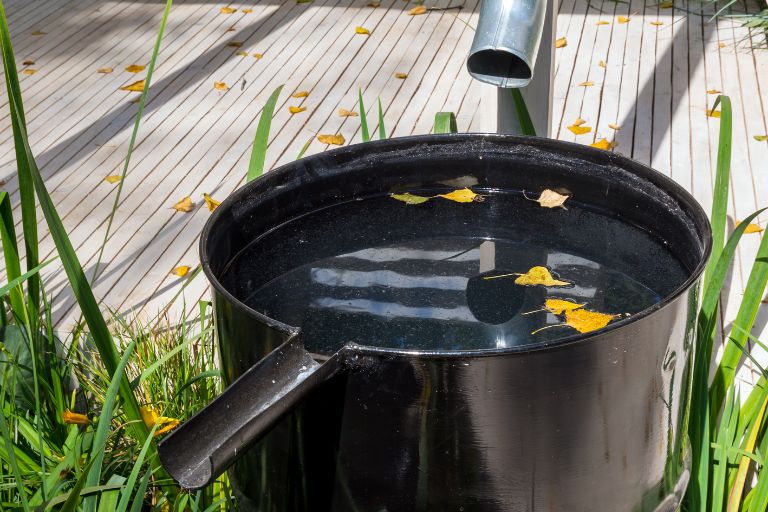
Setting Up a Rainwater Harvesting System for a Garage Garden
Assessing available space and requirements is essential when considering installing a rainwater harvesting system in a garage or surrounding area. The following are some tips to help you evaluate the space and determine its suitability for installing a rainwater harvesting system:
Evaluate roof size and material
– Determine the size and material of the roof where rainwater will be collected. The size of the roof will determine the potential amount of rainwater that can be collected.
– Consider the material of the roof (e.g. asphalt shingles, metal, tile) and its condition to ensure it is suitable for collecting rainwater without introducing contaminants into the system.
Evaluate the garage or outdoor space
– Evaluate the space available in the garage or surrounding outdoor area for installing rainwater storage tanks or barrels. Consider factors such as available floor space, headroom and accessibility.
– If indoor space is limited, explore options for outdoor installation, such as placing rain barrels along the side of the garage or against a wall.
Check local regulations and codes
– Before installing a rainwater harvesting system, check local ordinances, building codes and homeowners’ association (HOA) guidelines to ensure compliance with any permit requirements or restrictions.
– Some communities may have specific regulations regarding the installation, size and location of rainwater storage tanks or barrels, so it’s important to research local ordinances beforehand.
Consider accessibility and maintenance
– Ensure that the chosen location for rainwater storage tanks or barrels allows easy access for maintenance tasks such as cleaning, inspection and repairs.
– Consider factors such as proximity to downspouts for rainwater collection, accessibility for attaching hoses or pumps, and ease of monitoring water levels.
Determine water requirements and use
– Evaluate the water needs of the garden or landscape to determine the size and capacity of the rainwater harvesting system required. Consider factors such as the size of the garden, types of plants and frequency of watering.
– Evaluate other potential uses for the harvested rainwater, such as outdoor cleaning, car washing or non-potable domestic uses, to determine the total water demand.
Plan for overflow and drainage
– Consider options for managing overflow from rainwater storage tanks or barrels, especially during heavy rain events. Ensure that overflow outlets are directed away from the garage foundation and into suitable drainage areas to prevent water damage.
– Explore options for using overflow water for additional irrigation or directing it to permeable surfaces to promote groundwater recharge.
When selecting a rainwater harvesting system for a garage garden, several factors should be considered to ensure that the system meets the specific needs and constraints of the space. The following are some key factors to consider when choosing the right rainwater harvesting system:
Capacity
– Determine the water requirements of the garden or landscape to select a system with the appropriate capacity. Consider factors such as the size of the garden, types of plants and frequency of watering.
– Calculate the potential rainwater harvesting based on the size of the catchment area (e.g. roof) and the average rainfall in the area to determine the required storage capacity.
– Choose a system with sufficient storage capacity to meet water needs during dry periods or between rain events without overflowing or running out of water.
Materials
– Consider the materials used in the construction of the rainwater harvesting system, including storage tanks, piping and filtration components.
– Common materials for rainwater storage tanks include plastic (e.g. polyethylene), fibreglass, concrete and metal (e.g. galvanised steel). Each material has its advantages and considerations in terms of durability, cost and compatibility with the rainwater being collected.
– Ensure that the materials used are food grade and UV resistant to prevent degradation and contamination of the stored rainwater.
Space and installation
– Evaluate the space available for installing the rainwater harvesting system, both indoors (e.g. garage) and outdoors (e.g. next to the garage).
– Choose a system that fits within the available space and can be easily installed without obstructing access or interfering with other structures or utilities.
– Consider factors such as headroom, access for maintenance and proximity to downspouts for rainwater collection.
Filtration and treatment
– Evaluate the filtration and treatment capabilities of the rainwater harvesting system to ensure that the harvested rainwater is of suitable quality for its intended use.
– Select a system with appropriate filtration components such as leaf screens, gutter guards and sediment filters to remove debris and contaminants from the collected rainwater.
– Consider additional treatment options, such as UV sterilisation or chlorination, if the harvested rainwater will be used for potable purposes or if microbial contamination is a concern.
Budget
– Establish a budget for the rainwater harvesting system, taking into account the costs associated with purchasing and installing the system, as well as any ongoing maintenance costs.
– Compare the costs of different types of rainwater harvesting systems, including upfront costs, long-term savings on water bills, and any rebates or incentives offered by water utilities or government agencies.
– Balance the upfront investment with the expected benefits and savings over time to determine the most cost-effective option for your budget and needs.
Installing a rainwater harvesting system for a garage garden requires careful planning and attention to detail to ensure proper functionality and effectiveness. The following are step-by-step instructions for installing a basic rainwater harvesting system, such as a rain barrel, in a garage garden:
Determine placement
– Choose a suitable location for the rain barrel(s) within the garage or in the surrounding outdoor area. Ensure that the location is level, stable and provides easy access for maintenance.
– Consider placing the water butt(s) near a downspout to facilitate the collection of rainwater from the roof.
Prepare the site
– Clear the area around the chosen site and remove any obstructions or debris that may interfere with installation.
– Ensure that the ground is level and stable to prevent the water butt(s) from tipping over or moving once installed.
Install the downspout diverter (if applicable)
– If you are using a downspout diverter to direct rainwater into the water butt(s), follow the manufacturer’s installation instructions.
– Cut the downspout at the appropriate height and install the diverter according to the guidelines provided.
Position the butt(s)
– Place the water butt(s) in the chosen location, making sure they are stable and securely positioned.
– If necessary, use shims or levelling blocks to adjust the height and ensure that the butt(s) are level with the ground.
Connect the downpipe to the water butt(s)
– If you are not using a downspout diverter, position the water butt(s) directly under the downspout.
– Cut the downspout at the appropriate height to allow rainwater to flow into the water butt(s).
– Use a flexible downspout extension or elbow to direct water into the top opening of the water butt(s).
Secure the water butt(s)
– Anchor the rain barrel(s) to the ground or a nearby structure to prevent tipping or shifting during high winds or storms.
– Use straps, brackets or stakes to secure the water butt(s) in place.
Install overflow and drainage
– Install an overflow outlet near the top of the butt(s) to prevent overfilling during heavy rainfall.
– Direct overflow water away from the garage foundation to a suitable drainage area to prevent water damage.
Test the system and make adjustments
– Once the rain barrel(s) are installed, test the system by allowing rainwater to flow into the barrel(s) during a rain event.
– Monitor the system for leaks, overflow or other problems and make any necessary adjustments to ensure proper operation.
Maintenance and monitoring
– Inspect the water butt(s) regularly for debris, sediment build-up or signs of damage.
– Clean the butt(s) regularly to prevent contamination and maintain water quality.
– Monitor water levels and usage to ensure the rainwater harvesting system is meeting the needs of the garage garden.
Maintenance and Care
Regular maintenance is essential to ensure optimum performance and longevity of a rainwater harvesting system for a garage garden. The following are some of the reasons why regular maintenance is important:
Prevents contamination – Regular maintenance helps prevent contamination of harvested rainwater, keeping it safe for garden irrigation and other non-potable uses. Debris, sediment and organic matter can build up in rain barrels or storage tanks over time, creating an environment conducive to bacterial growth and waterborne pathogens. By regularly cleaning and inspecting the system, homeowners can remove contaminants and maintain water quality.
Maximises water storage capacity – Proper maintenance of rainwater storage tanks or barrels helps maximise water storage capacity and efficiency. Sediment build-up, algae growth or blockages in the system can reduce the effective volume of the storage tank and impede the flow of rainwater. Regular cleaning and maintenance, such as removing debris, flushing out sediment and unblocking filters, will help optimise water storage capacity and ensure an adequate supply of water for garden irrigation.
Extends equipment life – Regular maintenance helps extend the life of rainwater harvesting system components such as storage tanks, gutters, downspouts and filtration devices. Over time, exposure to the elements, debris and sediment build-up can cause wear and deterioration of system components, leading to leaks, corrosion or malfunction. By regularly inspecting and maintaining the system, homeowners can identify and address potential problems early, preventing costly repairs or replacement of equipment.
Prevents structural damage – Proper maintenance of rainwater harvesting infrastructure helps prevent structural damage to the garage, surrounding buildings and landscape features. Overflowing rain barrels or clogged gutters can cause water to pool around the garage foundation, leading to moisture intrusion, erosion and foundation settlement. Regular inspection and maintenance of scuppers, gutters and downspouts will help direct rainwater away from structures and prevent water-related damage.
Promotes system efficiency – Regular maintenance ensures that the rainwater harvesting system operates efficiently and effectively, optimising water capture, storage and distribution. Well-maintained gutters and downspouts facilitate the collection of rainwater from the roof, while clean filters and strainers prevent debris from entering the storage tank. Properly functioning pumps, valves and distribution systems ensure a reliable supply of water for garden irrigation and other uses, reducing water waste and promoting sustainable water management practices.
Regular cleaning and maintenance of rainwater harvesting components is essential to prevent blockages and contamination and to maintain optimum system performance. The following are guidelines for cleaning debris from gutters, filters and storage tanks:
Cleaning gutters
– Use a sturdy ladder and safety equipment such as gloves and goggles before climbing to clean gutters.
– Remove leaves, twigs and other debris by hand or with a shovel, starting at the downspout and working towards the opposite end.
– Dispose of collected debris in a compost bin or garden waste bag.
– Use a garden hose with a spray nozzle or a gutter cleaning attachment to flush out any remaining debris and clear any blockages. Direct the water towards the downspout to ensure proper drainage.
– Inspect gutters for signs of damage, such as rust, corrosion or loose fasteners, and make any necessary repairs to prevent leaks and ensure structural integrity.
Clean filters and sieves
– Remove filters, screens, or leaf guards from gutter downspouts or rain barrel inlets.
– Rinse filters and sieves with clean water to remove dirt, sediment and organic matter. Use a soft brush or sponge to gently scrub stubborn debris.
– Inspect filters and strainers for signs of damage or deterioration, such as cracks, holes or blockages, and replace if necessary.
– Allow filters and sieves to dry completely before reinstalling to prevent the growth of mould or mildew.
Cleaning storage tanks
– Drain the rainwater storage tank completely before cleaning to reduce the risk of contamination.
– Use a garden hose or pressure washer to rinse the inside walls of the storage tank to remove any sediment, algae or dirt.
– Scrub the inside of the tank with a non-toxic cleaner or diluted vinegar solution to remove stubborn stains or residue. Avoid using harsh chemicals or bleach as they may contaminate the stored rainwater.
– Rinse the tank thoroughly with clean water to remove any cleaning solution and allow it to dry completely before refilling.
– Inspect the tank lid, overflow outlet and inlet fittings for signs of damage or leaks and make any necessary repairs or replacements.
Regular maintenance schedule
– Establish a regular maintenance schedule for cleaning gutters, filters and storage tanks based on local weather conditions and the level of debris accumulation.
– Perform routine inspections and cleaning at least twice a year, preferably before the start of the rainy season and after the peak leaf fall in the autumn.
– Monitor the system regularly for signs of blockage, contamination or damage, and address any problems promptly to prevent costly repairs or system failure.
Winterising the rainwater harvesting system is essential to prevent damage from freezing and to ensure it continues to function during the colder months. The following are some tips on how to winterise the system:
Drain rain barrels and storage tanks
– Before freezing temperatures begin, completely drain rain barrels and storage tanks to prevent water from freezing and expanding, which can damage tank walls or fittings.
– Disconnect hoses, pumps and other accessories from the rain barrels or storage tanks and allow any remaining water to drain completely.
Disconnect downspouts and diverters
– Disconnect downspouts and diverters from rain barrels or storage tanks to prevent water from entering the system during freezing conditions.
– Ensure that downspouts are routed away from the garage foundation and into a suitable drainage area to prevent water accumulation and ice formation.
Remove filters and screens
– Remove filters, screens or leaf guards from gutter downspouts and rain barrel inlets to prevent debris build-up and clogging during the winter months.
– Thoroughly clean filters and screens before storing them indoors to prevent the growth of mould or mildew.
Insulate pipes and fittings
– Insulate exposed pipes, fittings and valves with foam pipe insulation or heat tape to protect them from freezing.
– Pay particular attention to outdoor pipes and fittings and any parts of the system located in unheated areas of the garage.
Protect outdoor components
– Cover rain barrels and storage tanks with insulated tank covers or heavy-duty tarps to provide additional protection against freezing temperatures and ice formation.
– Secure covers or tarps tightly to prevent wind damage and ensure adequate insulation.
Monitor weather conditions
– Stay informed about local weather forecasts and temperature fluctuations during the winter months.
– Take proactive measures to winterise the rainwater harvesting system well in advance of freezing temperatures, ideally before the first frost of the season.
Carry out regular inspections
– Inspect the rainwater harvesting system regularly throughout the winter season for signs of ice build-up, damage or leaks.
– Clear snow and ice from system components such as gutters, downspouts and storage tanks to prevent damage and ensure proper operation.
Resume regular maintenance in the spring
Once the threat of freezing temperatures has passed, resume regular maintenance such as cleaning gutters, filters and storage tanks to prepare the rainwater harvesting system for the spring and summer seasons.
Tips for Maximizing Rainwater Usage in Garage Gardens
Creating a watering schedule for a garage garden based on rainfall and garden needs requires careful consideration of factors such as climate, soil type, plant species and seasonal weather patterns. The following are some guidelines for developing an effective watering schedule:
Monitor rainfall
– Keep track of rainfall in your area using a rain gauge or by checking local weather reports.
– Note the frequency and intensity of rainfall events to determine how much water your garden receives naturally.
Assess soil moisture
– Regularly check the soil moisture in your garden by inserting your finger or a soil moisture meter into the soil to a depth of a few centimetres.
– Water the garden if the soil feels dry to the touch or if the moisture level is below the recommended range for your plants.
Consider plant needs
– Different plants have different water requirements depending on their species, size, stage of growth and environmental conditions.
– Group plants with similar water needs together and adjust your watering schedule accordingly to avoid over or under watering.
Adjust for seasonal changes
– Adjust your watering schedule seasonally to account for changes in temperature, humidity, daylight hours and plant growth rates.
– Increase watering frequency during hot, dry periods and decrease during cooler, wetter seasons.
Practice watering efficiency
– Water the garden in the early morning or late afternoon to minimise water loss through evaporation and ensure optimum absorption by plant roots.
– Use drip irrigation or soaker hoses to deliver water directly to the base of plants, reducing water waste and promoting deep root penetration.
– Apply a layer of mulch around plants to retain soil moisture, suppress weed growth and moderate soil temperature.
Use rainwater harvesting
– Incorporate harvested rainwater into your watering schedule to supplement irrigation during dry periods.
– Use stored rainwater from rain barrels or cisterns to water the garden when rainfall is scarce, reducing reliance on municipal water sources.
Adjust based on garden response
– Regularly monitor the health and growth of your garden plants to gauge their response to watering.
– Adjust your watering schedule as needed based on plant stress symptoms such as wilting, yellowing leaves or stunted growth.
Be flexible
– Be flexible with your watering schedule and adjust it as needed based on changing weather conditions, plant needs and environmental factors.
– Experiment with different watering techniques and frequencies to find the optimum balance for your garage garden.
Optimising water use in the garden is essential for conserving water resources and promoting sustainable gardening practices. The following are some tips on how to maximise water efficiency in the garden:
Mulch
– Apply a layer of organic mulch, such as shredded bark, straw or compost, around garden plants to retain soil moisture, suppress weed growth and moderate soil temperature.
– Mulching helps reduce evaporation of water from the soil surface, allowing plants to access moisture more efficiently and reducing the need for frequent watering.
Drip irrigation
– Install a drip irrigation system to deliver water directly to the root zone of plants, minimising water waste through evaporation and run-off.
– Drip irrigation systems use low-pressure emitters or tubing to distribute water slowly and evenly, promoting deep root penetration and efficient water uptake by plants.
– Use a timer or moisture sensor with your drip irrigation system to regulate watering schedules based on plant needs and soil moisture levels.
Watering techniques
– Water the garden in the early morning or late afternoon to minimise water loss through evaporation and ensure optimum absorption by plant roots.
– Water plants deeply and infrequently rather than shallowly and frequently to encourage deep root growth and drought tolerance.
– Use a watering can or hose with a nozzle attachment to direct water directly to the base of plants, avoiding overhead watering which can lead to water waste and foliar disease.
Choose drought-resistant plants
– Choose drought-tolerant or native plants that are well adapted to your climate and soil conditions.
– Drought-resistant plants typically have deep root systems, succulent foliage, or other adaptations that allow them to thrive with minimal water requirements.
– Incorporate a variety of drought-tolerant plants into your garden design to create a diverse and resilient landscape that can withstand periods of dry weather.
Improve soil health
– Amend soil with organic matter, such as compost or aged manure, to improve soil structure, water retention and nutrient availability.
– Healthy soil with good structure and organic matter holds moisture better, reducing the need for frequent watering and promoting plant health and vitality.
Practice water-wise gardening
– Group plants with similar water needs in the garden to simplify watering and avoid over or under watering.
– Monitor soil moisture levels regularly and adjust watering schedules based on weather conditions, plant growth and environmental factors.
– Use rainwater harvesting systems to collect and store rainwater for garden irrigation, reducing reliance on municipal water sources and promoting water conservation.
Monitoring water levels in rainwater storage tanks is essential to avoid overfilling or running out of water and to ensure efficient use of harvested rainwater. The following are several methods of monitoring water levels in rainwater storage tanks:
Visual inspection
– Regularly visually inspect the water level in the rainwater storage tank by looking inside the tank or at a sight gauge, if installed.
– Install a clear or translucent section in the tank or use a gauge with markings to visually indicate the water level.
– Check the water level during routine maintenance, such as cleaning or refilling the tank, to ensure adequate water supply.
Float switches
– Install a float switch in the rainwater storage tank to automatically monitor the water level and trigger a pump or valve to stop filling the tank when it reaches a predetermined level.
– Float switches consist of a buoyant float connected to a switching mechanism that is activated when the water level rises or falls.
– Programmable float switches can be set to maintain specific water levels and prevent overfilling or emptying of the tank.
Water level sensors
– Use electronic water level sensors or probes to monitor the water level in the rainwater storage tank.
– Water level sensors are typically installed at various heights in the tank and connected to a control panel or monitoring system that displays real-time water levels.
– Ultrasonic, pressure or capacitance sensors are commonly used to measure water levels accurately and reliably.
Manual dipstick
– Use a manual dipstick or measuring rod to manually check the water level in the rainwater storage tank.
– Insert the dipstick into the tank until it reaches the bottom and pull it out to observe the water level.
– Mark the dipstick with graduations or measurements to indicate water levels and track changes over time.
Wireless monitoring systems
– Install a wireless monitoring system that uses sensors or probes to measure water levels in the rainwater storage tank.
– Wireless monitoring systems transmit real-time data to a central control unit or smartphone app, allowing users to monitor water levels remotely and receive alerts for low or high water levels.
– Some wireless monitoring systems also offer additional features such as leak detection, temperature monitoring and historical data tracking.
Rainwater harvesting controllers
– Use specialised rainwater harvesting controllers or management systems that integrate water level monitoring with pump control, irrigation scheduling and data logging.
– Rainwater harvesting controllers automate system operation based on pre-set settings and sensor inputs, optimising water use and system efficiency.
Rainwater harvesting provides an effective and sustainable solution for watering garage gardens while promoting water conservation and environmental stewardship. By collecting and storing rainwater from rooftops or other surfaces, homeowners can reduce their reliance on municipal water sources, minimise storm water runoff and support healthy plant growth without depleting natural water resources.
Throughout this article, we have explored various aspects of rainwater harvesting for garage gardens, including system types, installation procedures, maintenance practices and water conservation strategies. From choosing the right system and optimising water use to monitoring water levels and winterising the system, homeowners can implement a number of techniques to maximise the efficiency and effectiveness of their rainwater harvesting systems.
Homeowners can further improve the sustainability of their garage gardens and reduce their environmental impact by implementing water-saving practices such as mulching, drip irrigation and selecting drought-tolerant plants. When homeowners incorporate rainwater harvesting into their gardening routine and follow best water management practices, they can enjoy the benefits of a lush and thriving garden while contributing to water conservation efforts and building resilience in the face of climate change.

